BY MARK OLSEN
At first glance, the science fiction films of the 1950s–and there were hundreds of them–may now look schlocky and selfsame, best left for the nostalgic memories of a happier era. On a closer inspection, however, many of these films reveal much of what makes Hollywood filmmaking worthwhile. Using the genre and its potential for allegory as cover, these films addressed the social and political issues of their times, notably the Cold War, the Atomic Age and the Communist Menace. At the same time, and often on a shoestring budget, they explored the boundaries of new and emerging filmmaking technologies.
Watching them now, it is shocking just how current, how relevant, these films still feel. Among the subjects raised are: the place of science within the fabric of American life; the capabilities, resources and trustworthiness of the American government and military; fear and paranoia of outside invaders bent on destroying our way of life; the use of technology as both an instrument of salvation and a tool of destruction; and the role of the media in society. These ideas were clearly as important in 1955 as they are in 2005.
This list is by no means comprehensive, as many other fine examples of fifties sci-fi (as well as notable oddities) are also available on DVD. The influence of these pictures is evident in such films as Bob Balaban's underrated satire Parents, Tim Burton's alien-invasion spoof Mars Attacks, and, of course, the entire Star Wars saga. The ability of these films to capture our imagination so many years after they were released speaks not only to the timelessness of the genre, but also to the skill, artistry and craftsmanship with which they were made.
War Of The Worlds (1953)
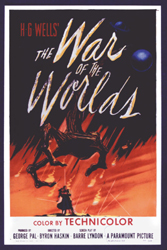 Recently remade by no less than Steven Spielberg, this earlier adaptation of the H.G. Wells classic is interesting in its own right and when compared to its modern-day version. Coming out in November as a Special Edition DVD complete with Orson Welles' infamous Mercury Theater radio broadcast that shocked the nation in 1938, this adaptation focuses on the attempts of a group of scientists to thwart the alien invaders. Directed by Byron Haskin and produced by George Pal, the film won an Academy Award for its special effects, which still look stylish and mesmerizing. The sleek modernist design of the spaceships contrasts nicely with the awkward organic forms of the alien invaders, who are glimpsed only briefly. (Paramount Home Video)
Recently remade by no less than Steven Spielberg, this earlier adaptation of the H.G. Wells classic is interesting in its own right and when compared to its modern-day version. Coming out in November as a Special Edition DVD complete with Orson Welles' infamous Mercury Theater radio broadcast that shocked the nation in 1938, this adaptation focuses on the attempts of a group of scientists to thwart the alien invaders. Directed by Byron Haskin and produced by George Pal, the film won an Academy Award for its special effects, which still look stylish and mesmerizing. The sleek modernist design of the spaceships contrasts nicely with the awkward organic forms of the alien invaders, who are glimpsed only briefly. (Paramount Home Video)
Forbidden Planet (1956)
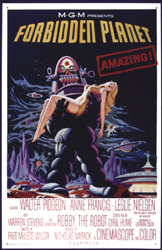 Shakespeare's The Tempest is reformed into a neo-Freudian drama on another world in this engaging and unusual film directed by Fred McLeod Wilcox, best known for his Lassie pictures. A space expedition (led by Leslie Nielsen) is sent to investigate what became of the crew from a previous mission. They find only two survivors, Morbius (Walter Pidgeon) and his daughter Alta (Anne Francis). Living in a paradise of rocket-age design, the father and daughter have reached a truce of sorts with the Krel, the mysterious force that rules the planet. As Morbius loosens his grip over his daughter and self-created paradise, the force is unleashed. Intelligent and sharp, hampered only perhaps by what now seems rather behind-the-beat pacing, Forbidden Planet also introduced one of the true icons of the fifties sci-fi boom, the lovable Robbie the Robot. (Warner Brothers Home Video)
Shakespeare's The Tempest is reformed into a neo-Freudian drama on another world in this engaging and unusual film directed by Fred McLeod Wilcox, best known for his Lassie pictures. A space expedition (led by Leslie Nielsen) is sent to investigate what became of the crew from a previous mission. They find only two survivors, Morbius (Walter Pidgeon) and his daughter Alta (Anne Francis). Living in a paradise of rocket-age design, the father and daughter have reached a truce of sorts with the Krel, the mysterious force that rules the planet. As Morbius loosens his grip over his daughter and self-created paradise, the force is unleashed. Intelligent and sharp, hampered only perhaps by what now seems rather behind-the-beat pacing, Forbidden Planet also introduced one of the true icons of the fifties sci-fi boom, the lovable Robbie the Robot. (Warner Brothers Home Video)
The Day The Earth Stood Still (1951)
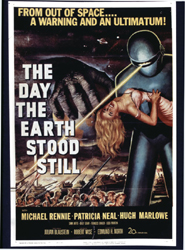 Aside from introducing the legendarily enigmatic line, "Gort, klaatu barada nikto," Robert Wise's film is also a stirring and thought-provoking meditation on tolerance and understanding, with a healthy dose of caution against imperialism and nuclear arms. After a spaceship lands in Washington D.C., out pops Klaatu, a human-looking being (played by an appropriately stone-faced Michael Rennie), accompanied by Gort, who turns out to be a robot enforcer used by the rest of the universe to eliminate aggression. Though the film is perhaps a little talky and prone to speech-making, there is nevertheless something thrilling about the way in which it so boldly confronts the very issues and fears that must have been foremost in the minds of the audience. (Fox Video)
Aside from introducing the legendarily enigmatic line, "Gort, klaatu barada nikto," Robert Wise's film is also a stirring and thought-provoking meditation on tolerance and understanding, with a healthy dose of caution against imperialism and nuclear arms. After a spaceship lands in Washington D.C., out pops Klaatu, a human-looking being (played by an appropriately stone-faced Michael Rennie), accompanied by Gort, who turns out to be a robot enforcer used by the rest of the universe to eliminate aggression. Though the film is perhaps a little talky and prone to speech-making, there is nevertheless something thrilling about the way in which it so boldly confronts the very issues and fears that must have been foremost in the minds of the audience. (Fox Video)
The Thing From Another World (1951)
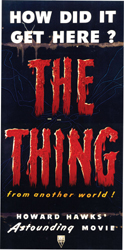 Though the director's attribution belongs to Christian Nyby, typically much of the credit for making this film has gone to producer Howard Hawks. It's easy to see why, as the film, the only foray into science fiction of Hawks' illustrious career, exhibits many of the tropes and thematic ideas that were benchmarks of his work. A military cadre joins up with a scientific team in the Arctic after they come across a flying saucer sunken beneath the ice, and together they all manage to dig out a being encased in a block of ice. Arguments ensue between a scientist, a military man and a reporter as to what to do–keep it quiet or tell the world, thaw it out or leave it be. The suspense is created largely by not letting the audience see The Thing. James Arness, who struggles mightily with awkward prosthetics and applications, ably portrays the creature. (Warner Brothers Home Video)
Though the director's attribution belongs to Christian Nyby, typically much of the credit for making this film has gone to producer Howard Hawks. It's easy to see why, as the film, the only foray into science fiction of Hawks' illustrious career, exhibits many of the tropes and thematic ideas that were benchmarks of his work. A military cadre joins up with a scientific team in the Arctic after they come across a flying saucer sunken beneath the ice, and together they all manage to dig out a being encased in a block of ice. Arguments ensue between a scientist, a military man and a reporter as to what to do–keep it quiet or tell the world, thaw it out or leave it be. The suspense is created largely by not letting the audience see The Thing. James Arness, who struggles mightily with awkward prosthetics and applications, ably portrays the creature. (Warner Brothers Home Video)
Invaders From Mars (1953)
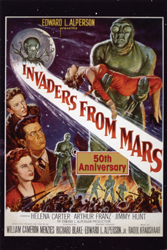 A terrific pairing on a double-bill with Invasion of the Body Snatchers, Invaders from Mars is the story of a young boy who wakes up in the middle of the night to see a flying saucer land just over a ridge near his home. Soon thereafter people around him begin to act strangely, even his own father seems like a different person. The one thing they all have in common is an odd scar at the base of their necks. Performances and sets are beautifully stylized thanks to skillful direction by renowned production designer William Cameron Menzies. The film feels as if Kafka's existential dread landed in that ship, not aliens. In a nice twist ending, the boy awakens to realize it was all just a dream, until he sees another ship land and the horrible loop begins again. (Image Entertainment)
A terrific pairing on a double-bill with Invasion of the Body Snatchers, Invaders from Mars is the story of a young boy who wakes up in the middle of the night to see a flying saucer land just over a ridge near his home. Soon thereafter people around him begin to act strangely, even his own father seems like a different person. The one thing they all have in common is an odd scar at the base of their necks. Performances and sets are beautifully stylized thanks to skillful direction by renowned production designer William Cameron Menzies. The film feels as if Kafka's existential dread landed in that ship, not aliens. In a nice twist ending, the boy awakens to realize it was all just a dream, until he sees another ship land and the horrible loop begins again. (Image Entertainment)
Invasion of the Body Snatchers (1953)
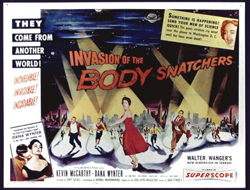 Director Don Siegel is now best remembered for his collaborations with Clint Eastwood on such films as Dirty Harry and Coogan's Bluff, but earlier in his career Siegel made this taut, terrifying film about a small town overtaken by pods which grow into dead-eyed replicas of the residents. The film nimbly doubles as both an atomic-age thriller and a cautionary statement on the conformity of post-World War II America, with more than a dash of Red Scare paranoia thrown in. Kevin McCarthy delivers a terrific performance as a doctor who returns home to find the people he knows and loves are no longer as they once were. Siegel originally wanted to end the film with McCarthy's direct-to-the-camera hysterics of shouting "You're Next!" but was forced to tack on an additional scene to soften the film's final moments. (Republic Pictures)
Director Don Siegel is now best remembered for his collaborations with Clint Eastwood on such films as Dirty Harry and Coogan's Bluff, but earlier in his career Siegel made this taut, terrifying film about a small town overtaken by pods which grow into dead-eyed replicas of the residents. The film nimbly doubles as both an atomic-age thriller and a cautionary statement on the conformity of post-World War II America, with more than a dash of Red Scare paranoia thrown in. Kevin McCarthy delivers a terrific performance as a doctor who returns home to find the people he knows and loves are no longer as they once were. Siegel originally wanted to end the film with McCarthy's direct-to-the-camera hysterics of shouting "You're Next!" but was forced to tack on an additional scene to soften the film's final moments. (Republic Pictures)